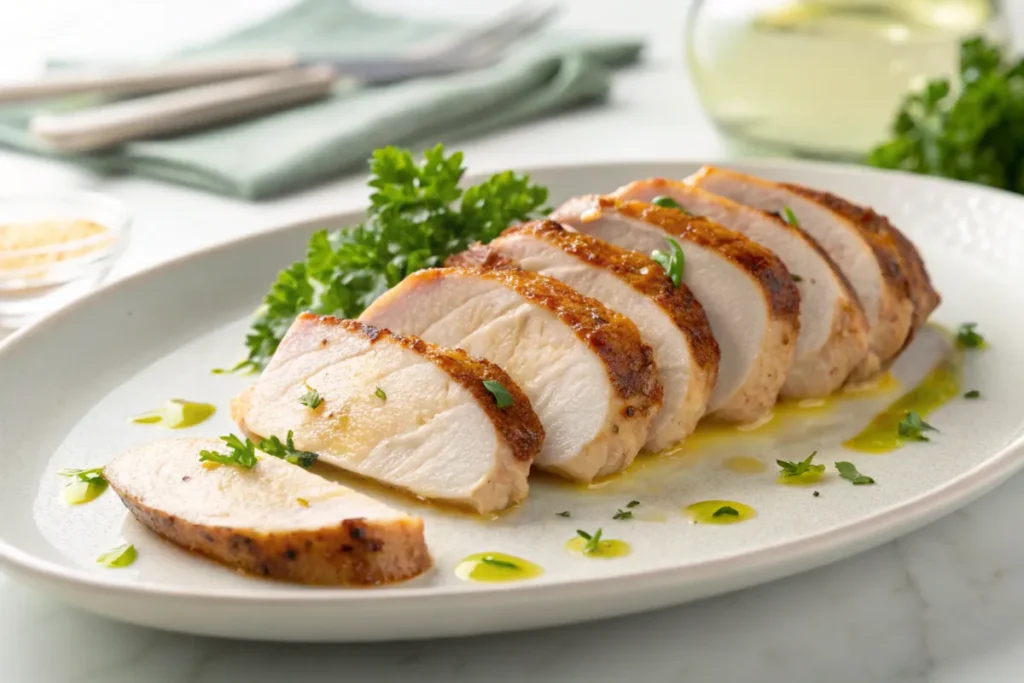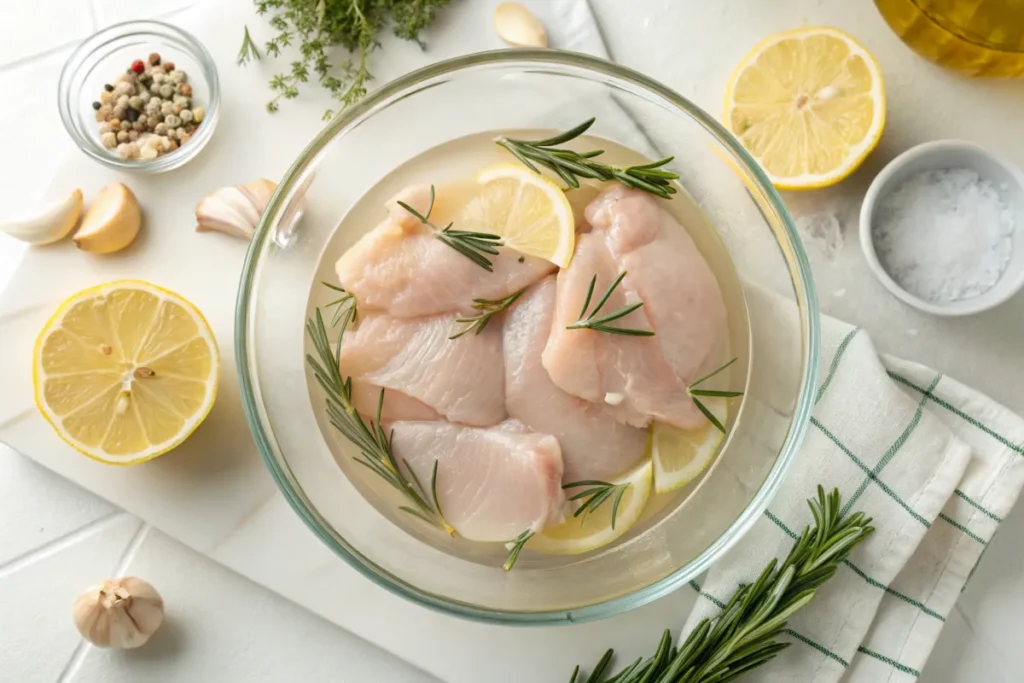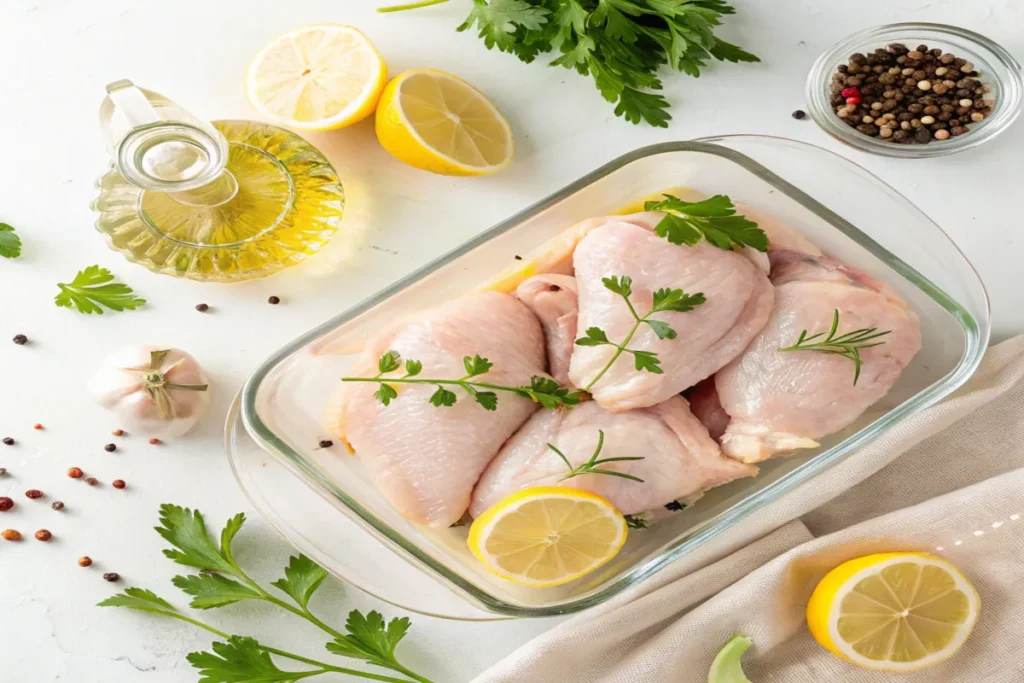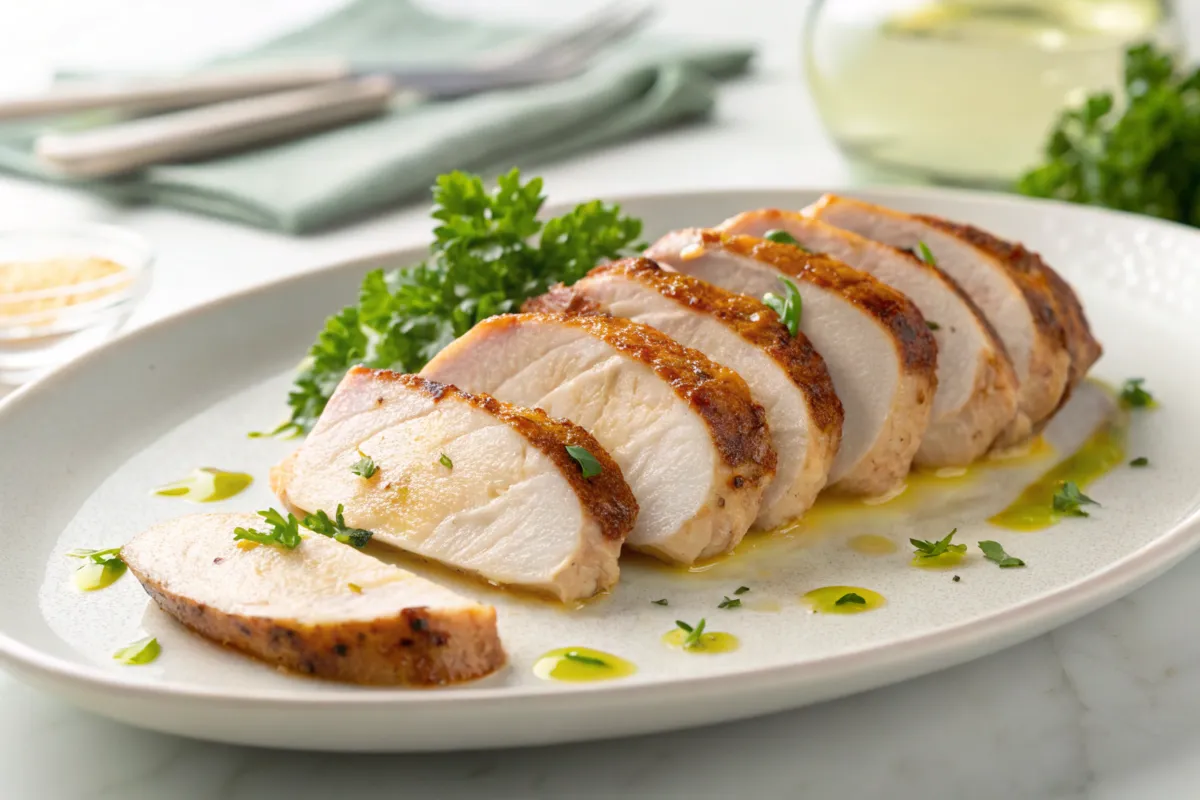| Cooking Time | |
|---|---|
| Preparation Time | 15 Minutes |
| Marinating Time | 30–60 Minutes |
| Cooking Time | 20 Minutes |
| Total Time | 1 Hour 15 Minutes |
Introduction: How to Make Chicken Breast Super Tender
Why Does Chicken Breast Dry Out?
If you’ve ever asked yourself, “How to make chicken breast super tender?”, you’re not alone. Cooking chicken breast can be tricky because it’s lean and prone to drying out. However, with the right techniques, you can transform this protein into a juicy, tender, and flavorful centerpiece for any meal. Whether you’re baking, grilling, or pan-searing, a few simple steps can make all the difference.
To begin, understanding why chicken breast often turns out dry is key. Because it’s naturally low in fat, overcooking even slightly can result in a tough texture. Therefore, it’s essential to use methods that enhance moisture and prevent overcooking.
Essential Techniques to Prevent Dryness
These include marinating, brining, and cooking at the correct temperature. Additionally, paying attention to resting times after cooking helps the juices redistribute evenly, ensuring every bite is tender.
One of the easiest ways to make chicken breast super tender is by using a marinade. A marinade not only adds flavor but also helps to break down the muscle fibers, making the meat softer. For example, combining acidic ingredients like lemon juice or vinegar with olive oil and spices creates a balanced marinade that tenderizes while enhancing the overall taste.
Brining: A Moisture-Boosting Method
Similarly, using a brine—a simple mixture of salt, water, and optional aromatics—infuses the chicken with moisture from the inside out. Furthermore, cooking methods play a crucial role.
Choose the Right Cooking Method
Low and slow techniques, like baking at a lower temperature or sous vide cooking, are excellent for preserving tenderness. On the other hand, high-heat methods like grilling or pan-searing require careful timing to avoid drying out the meat. Regardless of the method you choose, using a meat thermometer ensures precise results every time.
Balancing Moisture, Timing, and Temperature
Ultimately, learning how to make chicken breast super tender comes down to balancing moisture, timing, and temperature. By following these techniques, you’ll never have to deal with dry chicken again. Keep reading to discover detailed tips, tricks, and recipes that will elevate your chicken game to a whole new level.

How to Make Chicken Breast Super Tender Every Time
To make chicken breast super tender, it’s important to combine the right preparation methods with precise cooking techniques. By following these practical tips, you’ll achieve juicy, flavorful chicken breasts every time.
Start with Brining
Brining is one of the easiest and most effective ways to ensure tender chicken breast. By soaking the chicken in a mixture of water, salt, and optional aromatics, the meat absorbs moisture and becomes juicier.
Tip: Dissolve 1/4 cup of salt in 4 cups of water to create a basic brine. For extra flavor, add garlic, lemon slices, or fresh herbs to the mix. Let the chicken brine for at least 30 minutes or up to 2 hours in the refrigerator.
Not only does brining add moisture, but it also seasons the chicken throughout. As a result, you’ll notice improved flavor and tenderness, especially when baking or grilling.
Use a Marinade
Another excellent way to tenderize chicken is by using a marinade. Unlike brining, marinades work by combining acidic ingredients with fats and seasonings, which help break down proteins while infusing the meat with flavor.
Tip: Combine olive oil, lemon juice, garlic, and soy sauce for a quick, balanced marinade. Marinate the chicken for 1–2 hours in the fridge to enhance tenderness and taste.
However, avoid over-marinating, as the acidity can start to break down the meat too much. Therefore, shorter marination times are ideal for chicken breasts.

Pound the Chicken to an Even Thickness
One of the simplest yet often overlooked steps is pounding the chicken to an even thickness. Because uneven chicken breasts cook unevenly, the thinner parts may dry out while the thicker parts remain undercooked.
Tip: Place the chicken breast between two sheets of plastic wrap or parchment paper and gently pound it with a meat mallet or rolling pin until it’s evenly thick.
By doing this, you’ll not only reduce cooking time but also ensure consistent results. Moreover, even cooking prevents the need for guesswork and minimizes the risk of overcooking.
Cook at the Right Temperature
Cooking chicken breast at the right temperature is critical to maintaining its tenderness. High heat can dry out the meat quickly, so using a moderate temperature ensures better results.
Tip: Bake chicken breasts at 375°F (190°C) for 20–25 minutes or until the internal temperature reaches 165°F (74°C). Use a meat thermometer for accuracy.
Additionally, avoid cutting into the chicken immediately after cooking. Letting it rest for 5–10 minutes allows the juices to redistribute, which keeps the meat moist and tender.
Experiment with Low and Slow Cooking Methods
If you have the time, low and slow cooking methods like sous vide or slow baking are excellent for preserving tenderness. These techniques gently heat the chicken, preventing the proteins from tightening too much.
Tip: For sous vide, cook chicken breasts at 145°F (63°C) for 1–2 hours. Afterward, quickly sear them in a hot pan to add a golden crust.
Furthermore, slow cooking in a broth or sauce can also enhance the flavor while keeping the chicken moist. This method is especially useful for making shredded chicken.
Use a Flavorful Glaze or Sauce
Even when cooked perfectly, chicken breast can sometimes feel bland without a finishing touch. Adding a flavorful glaze or sauce not only enhances the taste but also adds moisture to the dish.
Tip: Brush chicken breasts with a honey and balsamic vinegar glaze during the last 5 minutes of cooking for a glossy, flavorful finish.
Alternatively, serve the chicken with a creamy sauce or fresh salsa to elevate the dish further. These additions not only boost flavor but also complement the tenderness of the meat.
Avoid Overcooking at All Costs
Perhaps the most important rule for tender chicken breast is to avoid overcooking. Even a few extra minutes can dry out the meat, so monitoring the cooking time is essential.
Tip: Always use a meat thermometer to check for doneness. Remove the chicken from heat as soon as it reaches 165°F (74°C), as it will continue to cook slightly while resting.
Additionally, cutting the chicken against the grain makes it easier to chew and keeps each bite tender and juicy.
Key Takeaways
By combining these tips, you’ll have everything you need to make chicken breast super tender. Remember to:
- Start with a brine or marinade to infuse flavor and moisture.
- Pound the chicken for even cooking and consistent results.
- Cook at the right temperature and let the meat rest before serving.
- Experiment with low and slow methods or finish with a flavorful glaze to enhance texture and taste.
Final Tip: Practice these techniques regularly, and soon you’ll master the art of cooking chicken breasts that are not only tender but also delicious and full of flavor.
Table of contents
- Introduction: How to Make Chicken Breast Super Tender
- How to Make Chicken Breast Super Tender Every Time
- Key Takeaways
- History and Science of Tenderizing Chicken
- Detailed Ingredients and Role of Each
- Step-by-Step Preparation Guide
- Cooking Methods to Keep Chicken Breast Juicy and Tender
- Serving Ideas for Perfectly Tender Chicken Breast
History and Science of Tenderizing Chicken
Tenderizing chicken breast isn’t a new idea—it has deep culinary roots and is supported by solid science. Understanding how traditional techniques and modern practices work can help you master this essential skill.
Historical Methods for Tenderizing Meat
Historically, cooks around the world have relied on natural methods to tenderize chicken and other meats. For example:
- In Asia, rice wine or fruit-based marinades were commonly used to break down proteins and enhance flavor.
- In Mediterranean regions, acidic ingredients like lemon juice and vinegar were staples in marinades for tenderizing and flavoring chicken.
- In America, methods like buttermilk brining became popular for fried chicken recipes, ensuring juicy and tender results.
As techniques evolved, chefs discovered that combining acid with fat and aromatics not only tenderized the chicken but also elevated its flavor profile.
Scientific Explanation
The science of tenderizing chicken breast lies in how acids, salts, and enzymes interact with proteins in the meat.
- Acids (e.g., lemon juice, vinegar, or yogurt):
- Break down muscle fibers and connective tissues, softening the meat.
- Allow marinades to penetrate deeper, infusing flavor.
- Salt in Brines:
- Dissolves some proteins, making the meat more tender.
- Helps retain moisture during cooking, preventing dryness.
- Enzymes (e.g., papaya or pineapple juice):
- Naturally occurring enzymes break down proteins for ultra-tender results.
- These are commonly used in marinades for tougher cuts but can be effective with chicken breast when used sparingly.
Tip: For a scientific edge, marinate chicken in a yogurt-based mixture. The combination of lactic acid and fat makes the chicken incredibly tender.

Detailed Ingredients and Role of Each
To make chicken breast super tender, the ingredients you use play a critical role. Here’s a detailed breakdown of what works and why:
Core Ingredients for Tenderizing Chicken
- Acidic Components:
- Lemon juice, vinegar, or yogurt to break down muscle fibers.
- Fat Sources:
- Olive oil or coconut milk to add moisture and balance the acidity.
- Salt:
- Enhances the chicken’s flavor and retains its moisture.
- Aromatics:
- Garlic, ginger, or herbs like rosemary for depth of flavor.
- Sweeteners (Optional):
- Honey or brown sugar to balance tangy flavors and caramelize during cooking.
Tip: Combine these ingredients into a marinade or brine for maximum impact. For example, mix olive oil, lemon juice, garlic, and rosemary for a Mediterranean-inspired marinade.
Step-by-Step Preparation Guide
| Step | Instruction |
|---|---|
| 1 | Brine the chicken breasts in a mixture of 4 cups water and 1/4 cup salt for at least 30 minutes. |
| 2 | Remove the chicken from the brine and pat dry with a paper towel. |
| 3 | Pound the chicken to an even thickness using a meat mallet. |
| 4 | Prepare a marinade with olive oil, lemon juice, garlic, and spices. Marinate the chicken for 30–60 minutes. |
| 5 | Preheat your oven to 375°F (190°C) or heat a skillet over medium-high heat. |
| 6 | Cook the chicken until it reaches an internal temperature of 165°F (74°C), about 6–7 minutes per side in a skillet or 20 minutes in the oven. |
| 7 | Let the chicken rest for 5 minutes before slicing and serving. |
Here’s how to prepare chicken breast for super tender results:
- Brining:
- Dissolve salt in warm water (1/4 cup salt to 4 cups water).
- Submerge chicken breasts in the brine for 30 minutes to 2 hours.
- Marinating:
- Prepare a marinade with a mix of acid, fat, and aromatics.
- Let the chicken soak for at least 1 hour, but no more than 2 hours.
- Pounding:
- Use a meat mallet or rolling pin to pound the chicken evenly.
- This ensures even cooking and prevents dryness.
- Resting:
- After marinating or brining, let the chicken rest at room temperature for 10 minutes before cooking.
Cooking Methods to Keep Chicken Breast Juicy and Tender
Each cooking method has its advantages, but the key is maintaining the chicken’s moisture.
- Baking:
- Bake at 375°F (190°C) for 20–25 minutes. Brush the chicken with olive oil or glaze halfway through for extra moisture.
- Grilling:
- Grill over medium-high heat for 6–7 minutes per side. Brush with marinade during cooking.
- Sous Vide:
- Cook chicken breasts at 145°F (63°C) for 1–2 hours, then sear for a golden crust.
- Stovetop Searing:
- Heat a pan with olive oil over medium-high heat. Sear the chicken for 5–6 minutes per side until golden brown.
Tip: Always use a meat thermometer to check for an internal temperature of 165°F (74°C).
Serving Ideas for Perfectly Tender Chicken Breast
- Plated Dishes: Pair with roasted vegetables, creamy mashed potatoes, or a fresh green salad.
- Sandwiches: Slice tender chicken breast for wraps, sliders, or baguette sandwiches.
- Bowls: Serve over rice, quinoa, or a grain bowl with a tangy dressing.
Tip: Drizzle chicken with a balsamic reduction or garlic butter sauce for added flavor.
Nutritional Information
| Nutrient | Per Serving |
|---|---|
| Calories | 250 kcal |
| Protein | 27 g |
| Carbohydrates | 3 g |
| Fat | 8 g |
| Sodium | 520 mg |
Nutritional values are approximate and can vary based on specific ingredients and measurements.

